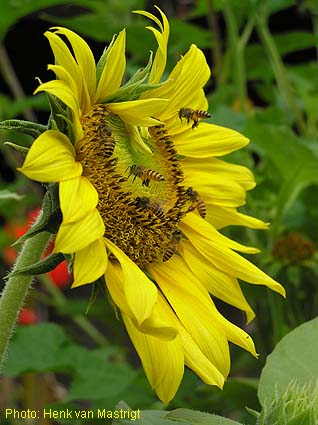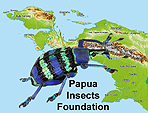

Papua-Insects.nl
The Papua Insects Foundation
The Bees (Hymenoptera: Apidae) of Papua Indonesia
with contributions by Claus Rasmussen
Listed are the Meliponini (Stingless Bees). Other tribes will follow soon.
Meliponini (by Claus Rasmussen)
Stingless bees are a large and diverse tropical and subtropical group of social bees. Their diversity include perennial colonies that range in size from fewer than 100 to tens of thousands of workers. They are able to utilize diverse and elaborate communication systems with well-developed recruitment mechanisms that include scent-marking and acoustical communication. Species vary considerably in their nest architecture, which ranges from brood cells in horizontal combs or clusters, constructed within crevices or in the ground, and occasionally within the active colonies of other social insects.
The island of New Guinea has only few species. Two of the genera are either endemic or unusually diverse in New Guinea: Papuatrigona and Platytrigona, other two genera have dispersed to the island with the majority of the diversity either west in the Indo-Malay region (Tetragonula) or south, in Australia (Austroplebeia, Tetragonula). Most species appear to be widespread, with only Platytrigona restricted to certain areas, although sampling is very scattered and additional records and species are very likely to occur following field collections and comprehensive taxonomic treatments. All of the species, except all of Tetragonula, are endemic to New Guinea.
For distinguishing characters click here.
This list is under continued construction. Check now and then for updates.
Listed species from New Guinea: 10 [7 endemic species]
Tribus Meliponini (by Claus Rasmussen)
Austroplebeia Moure, 1961
cincta (Mocsary, 1898)
Papuatrigona Michener & Sakagami, 1990
genalis (Friese, 1908)
Platytrigona Moure, 1961
atricornis (Smith, 1865)
keyensis (Friese, 1901)
flaviventris (Friese, 1908)
lamingtonia (Cockerell, 1929)
planifrons (Smith, 1865)
Tetragonula Moure, 1961
biroi (Friese, 1898)
clypearis (Friese, 1908)
sapiens (Cockerell, 1911)
last updated on 21st April 2008
Literature
Dollin A.E., Dollin L.J., Sakagami S.F. (1997) Australian stingless bees of the genus Trigona (Hymenoptera: Apidae). Invertebrate taxonomy 11: 861-896.
Friese H. (1909) Die Bienenfauna von Neu-Guinea. Annales historico-naturales Musei Nationalis Hungarici (Termeszettudomanyi Muzeum evkonyve) 7: 179-288.
Friese H. (1911) Apidae. Resultate der Expedition zum Schneegebirge in Niederländ Süd-Neu-Guinea, 1909/10, in: Wichmann A. (Eds.), Nova Guinea. Résultats de l'expédition scientifique néerlandaise à la Nouvelle-Guinée en 1903, E.J. Brill, Leiden: 261-263.
Friese H. (1912) Zur Bienenfauna von Neu-Guinea und Oceanien. Übersicht des von den Herren Dahl, Finsch, Krämer, Moszkowski, Neuhaus, Schoede und L. Schultze in den letzten Jahren dem Zoologischen Museum in Berlin überwiesenen Forschungsmaterials. Mitteilungen aus dem Zoologischen Museum in Berlin 6: 91-96.
Friese H. (1915) Apiden aus Nord-Neu-Guinea gesammelt von Dr. P. N. van Kampen und K. Gjellerup, in den Jahren 1910 und 1911. Tijdschrift voor Entomologie 58: 1-4.
Hohmann H. (2003) Zur Kommunikation stachelloser Bienen in Neuguinea. TenDenZen (Jahrbuch Überseemuseum Bremen) 11: 9-26.
Michener C.D. (1961) Observations on the nests and behavior of Trigona in Australia and New Guinea (Hymenoptera, Apidae). American museum novitates 2026: 1-46.
Michener C.D. (1990) Classification of the Apidae (Hymenoptera). Appendix: Trigona genalis Friese, a hitherto unplaced New Guinea species. University of Kansas science bulletin 54: 75-164.
Michener C.D. (2007) The bees of the world, second edition, Johns Hopkins University Press, Baltimore: xvi+953.